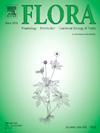含羞草属(豆科,含羞草科,含羞草科)7种含羞草属植物小叶形态解剖学特征与分类生态学的相关性
IF 1.8
4区 生物学
Q3 ECOLOGY
引用次数: 0
摘要
含羞草属是复杂的;它分布在各种各样的栖息地,其中几个物种的划分仍然存在问题。迄今为止,大多数物种的小叶形态解剖学尚未被探索,尽管这种探索不仅可以使物种区分,而且可以提供有关环境的信息。因此,本文对含羞草属7种植物小叶的形态解剖特征进行了分类和生态学意义的研究。在每个种的三个个体中观察到三个小叶的结构和解剖结构。通过方差分析评估种间差异。进行了相似性分析和非度量多维尺度分析。利用规范对应分析表明性状与多个环境变量相关。具有特定分类价值的特征包括初生脉类型、气孔复体类型、叶肉类型、是否存在双分枝小脉以及初生脉上的角质层褶皱。相似性分析将这些物种按其所属的组(M. sect. Batocaulon, M. sect. Habbasia和M. sect. Mimosa)分组。此外,这些性状与抵御太阳辐射、减少水分流失、优化水分运输和光合作用有关。本研究表明,小叶形态解剖学特征对解决含羞草的分类学问题具有重要意义,可以为含羞草物种的生存策略提供洞见,从而为今后的研究指明方向。本文章由计算机程序翻译,如有差异,请以英文原文为准。
Relevance of leaflet morphoanatomical characters in the taxonomy and ecology of seven species of the genus Mimosa (Leguminosae, Caesalpinioideae, Mimoseae)
The genus Mimosa is complex; it is distributed in a wide variety of habitats, and the delimitation of several of its species remains problematic. To date, leaflet morphoanatomy has not been explored in most of its species, despite the fact that such exploration would not only make it possible for the species to be distinguished but also provide information about the environment. It was for these reasons that the taxonomical and ecological implications of the morphoanatomical characters of seven Mimosa species’ leaflets were determined. The architecture and anatomy of three leaflets were observed in three individuals per species. Interspecific differences were evaluated through analysis of variance. Similarity analysis and a non-metric multidimensional scaling analysis were performed. Traits showed associations with several environmental variables using canonical correspondence analysis. The characters with specific taxonomic value include primary venation type, stomatal complex type, mesophyll type, presence or absence of twice-branched veinlets, and cuticular folds over the primary vein. The analysis of similarities grouped the species according to the section to which they belong (M. sect. Batocaulon, M. sect. Habbasia, and M. sect. Mimosa). Furthermore, the characters are associated with protection against solar radiation, reduction of water loss, and optimization of water transport and photosynthesis. This study demonstrates that leaflet morphoanatomical characters are important for the resolution of taxonomic problems and can provide insight into the survival strategies employed by Mimosa species, thus pointing the way for future exploration of the topic.
求助全文
通过发布文献求助,成功后即可免费获取论文全文。
去求助
来源期刊

Flora
生物-植物科学
CiteScore
3.30
自引率
10.50%
发文量
130
审稿时长
54 days
期刊介绍:
FLORA publishes original contributions and review articles on plant structure (morphology and anatomy), plant distribution (incl. phylogeography) and plant functional ecology (ecophysiology, population ecology and population genetics, organismic interactions, community ecology, ecosystem ecology). Manuscripts (both original and review articles) on a single topic can be compiled in Special Issues, for which suggestions are welcome.
FLORA, the scientific botanical journal with the longest uninterrupted publication sequence (since 1818), considers manuscripts in the above areas which appeal a broad scientific and international readership. Manuscripts focused on floristics and vegetation science will only be considered if they exceed the pure descriptive approach and have relevance for interpreting plant morphology, distribution or ecology. Manuscripts whose content is restricted to purely systematic and nomenclature matters, to geobotanical aspects of only local interest, to pure applications in agri-, horti- or silviculture and pharmacology, and experimental studies dealing exclusively with investigations at the cellular and subcellular level will not be accepted. Manuscripts dealing with comparative and evolutionary aspects of morphology, anatomy and development are welcome.
 求助内容:
求助内容: 应助结果提醒方式:
应助结果提醒方式:


